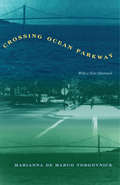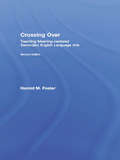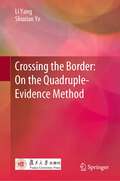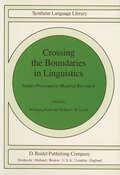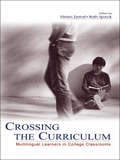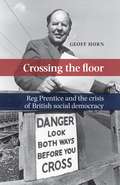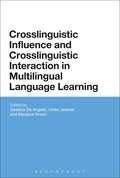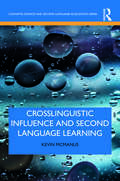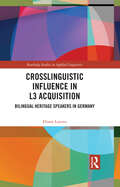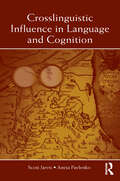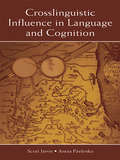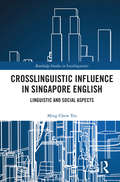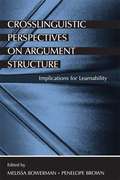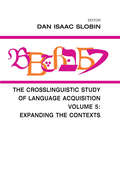- Table View
- List View
Crossing Ocean Parkway
by Marianna De TorgovnickGrowing up an Italian-American in the Bensonhurst neighborhood of New York city, Marianna De Marco longed for college, culture, and upward mobility. Her daydreams circled around WASP (White Anglo Saxon Protestant) heroes on television—like Robin Hood and the Cartwright family—but in Brooklyn she never encountered any. So she associated moving up with Ocean Parkway, a street that divides the working-class Italian neighborhood where she was born from the middle-class Jewish neighborhood into which she married. This book is Torgovnick's unflinching account of crossing cultural boundaries in American life, of what it means to be an Italian American woman who became a scholar and literary critic. Included are autobiographical moments interwoven with engrossing interpretations of American cultural icons from Dr. Dolittle to Lionel Trilling, The Godfather to Camille Paglia. Her experiences allow her to probe the cultural tensions in America caused by competing ideas of individuality and community, upward mobility and ethnic loyalty, acquisitiveness and spirituality.
Crossing Ocean Parkway
by Marianna De TorgovnickGrowing up an Italian-American in the Bensonhurst neighborhood of New York city, Marianna De Marco longed for college, culture, and upward mobility. Her daydreams circled around WASP (White Anglo Saxon Protestant) heroes on television—like Robin Hood and the Cartwright family—but in Brooklyn she never encountered any. So she associated moving up with Ocean Parkway, a street that divides the working-class Italian neighborhood where she was born from the middle-class Jewish neighborhood into which she married. This book is Torgovnick's unflinching account of crossing cultural boundaries in American life, of what it means to be an Italian American woman who became a scholar and literary critic. Included are autobiographical moments interwoven with engrossing interpretations of American cultural icons from Dr. Dolittle to Lionel Trilling, The Godfather to Camille Paglia. Her experiences allow her to probe the cultural tensions in America caused by competing ideas of individuality and community, upward mobility and ethnic loyalty, acquisitiveness and spirituality.
Crossing Ocean Parkway
by Marianna De TorgovnickGrowing up an Italian-American in the Bensonhurst neighborhood of New York city, Marianna De Marco longed for college, culture, and upward mobility. Her daydreams circled around WASP (White Anglo Saxon Protestant) heroes on television—like Robin Hood and the Cartwright family—but in Brooklyn she never encountered any. So she associated moving up with Ocean Parkway, a street that divides the working-class Italian neighborhood where she was born from the middle-class Jewish neighborhood into which she married. This book is Torgovnick's unflinching account of crossing cultural boundaries in American life, of what it means to be an Italian American woman who became a scholar and literary critic. Included are autobiographical moments interwoven with engrossing interpretations of American cultural icons from Dr. Dolittle to Lionel Trilling, The Godfather to Camille Paglia. Her experiences allow her to probe the cultural tensions in America caused by competing ideas of individuality and community, upward mobility and ethnic loyalty, acquisitiveness and spirituality.
Crossing Ocean Parkway
by Marianna De TorgovnickGrowing up an Italian-American in the Bensonhurst neighborhood of New York city, Marianna De Marco longed for college, culture, and upward mobility. Her daydreams circled around WASP (White Anglo Saxon Protestant) heroes on television—like Robin Hood and the Cartwright family—but in Brooklyn she never encountered any. So she associated moving up with Ocean Parkway, a street that divides the working-class Italian neighborhood where she was born from the middle-class Jewish neighborhood into which she married. This book is Torgovnick's unflinching account of crossing cultural boundaries in American life, of what it means to be an Italian American woman who became a scholar and literary critic. Included are autobiographical moments interwoven with engrossing interpretations of American cultural icons from Dr. Dolittle to Lionel Trilling, The Godfather to Camille Paglia. Her experiences allow her to probe the cultural tensions in America caused by competing ideas of individuality and community, upward mobility and ethnic loyalty, acquisitiveness and spirituality.
Crossing Over: Teaching Meaning-centered Secondary English Language Arts
by Harold M. FosterThis text for secondary preservice and in-service English language arts teachers offers a rationale for meaning-centered English language arts teaching and practical strategies for application. Its goal is to provide readers with an understanding of the issues involved in English teaching and specific examples of how to apply this understanding to classrooms. Teaching strategies are presented through a series of stories depicting teachers from a variety of settings practicing their craft with secondary students. Features: *A solid introduction and interesting personal narratives introduce the issues and ideas involved in English language arts teaching. *Case studies based on actual teachers and students realistically illustrate methods that can be used in secondary English classes. *Lessons are described in sufficient detail to be converted to teaching models. *Multicultural emphasis prepares teachers for the contemporary classroom. *Chapters and sections incorporate the new literacies of TV, film, and computers in the English language arts class. *Pedagogical aids include end-of-chapter questions and activities, reproducible charts and worksheets; an updated listing of young adult novels; and annotated recommended readings. *An appendix on writing a personal narrative helps students develop as writers. New in the Second Edition: *Updates. All chapters, the bibliographies, and the references are thoroughly updated to reflect changes since the first edition was published. Chapters 1 and 2 have been totally rewritten. *Standards/Benchmarks. The IRA/NCTE Standards for the English Language Arts are incorporated into the text. Benchmarks and Performance Assessment Measures are included in all the pedagogical chapters to address proficiency concerns. A section on helping students prepare for state proficiency tests has been added. *Computers. More is included on the use of technology, both as a content to learn and as a process for learning. *New Sample Unit Plans. Sections based on the instructional stories offer examples to help readers prepare for teaching. *Literature response questions. These are now provided in Chapter 4 for use in journaling and discussions. *Glossary. A chapter on important terms and useful strategies for the English language arts classroom has been added.
Crossing Over: Teaching Meaning-centered Secondary English Language Arts
by Harold M. FosterThis text for secondary preservice and in-service English language arts teachers offers a rationale for meaning-centered English language arts teaching and practical strategies for application. Its goal is to provide readers with an understanding of the issues involved in English teaching and specific examples of how to apply this understanding to classrooms. Teaching strategies are presented through a series of stories depicting teachers from a variety of settings practicing their craft with secondary students. Features: *A solid introduction and interesting personal narratives introduce the issues and ideas involved in English language arts teaching. *Case studies based on actual teachers and students realistically illustrate methods that can be used in secondary English classes. *Lessons are described in sufficient detail to be converted to teaching models. *Multicultural emphasis prepares teachers for the contemporary classroom. *Chapters and sections incorporate the new literacies of TV, film, and computers in the English language arts class. *Pedagogical aids include end-of-chapter questions and activities, reproducible charts and worksheets; an updated listing of young adult novels; and annotated recommended readings. *An appendix on writing a personal narrative helps students develop as writers. New in the Second Edition: *Updates. All chapters, the bibliographies, and the references are thoroughly updated to reflect changes since the first edition was published. Chapters 1 and 2 have been totally rewritten. *Standards/Benchmarks. The IRA/NCTE Standards for the English Language Arts are incorporated into the text. Benchmarks and Performance Assessment Measures are included in all the pedagogical chapters to address proficiency concerns. A section on helping students prepare for state proficiency tests has been added. *Computers. More is included on the use of technology, both as a content to learn and as a process for learning. *New Sample Unit Plans. Sections based on the instructional stories offer examples to help readers prepare for teaching. *Literature response questions. These are now provided in Chapter 4 for use in journaling and discussions. *Glossary. A chapter on important terms and useful strategies for the English language arts classroom has been added.
Crossing the Border: On the Quadruple-Evidence Method
by Li Yang Shuxian YeThis book is the first monograph of its kind in the academic world which comprehensively expounds the new methodology of humanities. The quadruple-evidence method is one which integrates quadruple-evidences to open up new horizon for interpretation of ancient culture in the three-dimensional manner. The first layer of evidence refers to documents passed down from the past; the second layer of evidence refers to local written materials; the third layer of evidence includes oral legends of anthropology and folklore and etiquette in the living folk customs; the fourth layer of evidence refers to those ancient objects and images either unearthed in archaeological excavations or handed down from the past. The book consists of theoretical explorations and their applications in individual cases. While the first part studies the academic evolution, theory and methodological value of the quadruple-evidence method, the second part, in using the method in different cases, explores different historical and cultural phenomena in the history of China, attempting to extend the frontier of the origin of civilization from the approach of mythological study
Crossing the Boundaries in Linguistics: Studies Presented to Manfred Bierwisch (Studies in Linguistics and Philosophy #13)
by Wolfgang Klein and Willem LeveltCrossing the Curriculum: Multilingual Learners in College Classrooms
by Vivian Zamel Ruth SpackAs college classrooms have become more linguistically diverse, the work of ESOL professionals has expanded to include research on the experiences of multilingual learners not only in ESOL courses but also in courses across the curriculum. At the same time that ESOL professionals are trying to understand the academic challenges that learners face beyond ESOL courses, faculty across the disciplines are trying to meet the challenge of teaching students of differing linguistic backgrounds. Crossing the Curriculum: Multilingual Learners in College Classrooms responds to these issues and concerns by capturing the complex and content-specific nature of students' and teachers' experiences and providing a nuanced understanding of how multilingual students' learning can be fostered and sustained. Crossing the Curriculum: Multilingual Learners in College Classrooms is unique in bringing together the perspectives of researchers, students, and teachers. These multiple lenses allow for a richly layered picture of how students and teachers actually experience college classrooms. Common themes and pedagogical principles resonate across the three distinct sections of the book:*Part One, "Investigating Students' Experiences Across the Curriculum: Through the Eyes of Classroom Researchers," consists of chapters written by ESOL and composition researchers who have investigated multilingual students' experiences in undergraduate courses across the curriculum.*Part Two, "Learning Across the Curriculum: Through Students' Eyes," consists of chapters written by two multilingual learners who chronicled their experiences as they crossed the curriculum over time.*Part Three, "Engaging Students in Learning: Through the Eyes of Faculty Across the Curriculum," consists of chapters written by faculty from several academic fields--Anthropology, Philosophy, Nursing, Literature, Sociology, and Asian American Studies--who discuss their own attempts to address the needs of multilingual learners in their classrooms.
Crossing the Curriculum: Multilingual Learners in College Classrooms
by Vivian Zamel Ruth SpackAs college classrooms have become more linguistically diverse, the work of ESOL professionals has expanded to include research on the experiences of multilingual learners not only in ESOL courses but also in courses across the curriculum. At the same time that ESOL professionals are trying to understand the academic challenges that learners face beyond ESOL courses, faculty across the disciplines are trying to meet the challenge of teaching students of differing linguistic backgrounds. Crossing the Curriculum: Multilingual Learners in College Classrooms responds to these issues and concerns by capturing the complex and content-specific nature of students' and teachers' experiences and providing a nuanced understanding of how multilingual students' learning can be fostered and sustained. Crossing the Curriculum: Multilingual Learners in College Classrooms is unique in bringing together the perspectives of researchers, students, and teachers. These multiple lenses allow for a richly layered picture of how students and teachers actually experience college classrooms. Common themes and pedagogical principles resonate across the three distinct sections of the book:*Part One, "Investigating Students' Experiences Across the Curriculum: Through the Eyes of Classroom Researchers," consists of chapters written by ESOL and composition researchers who have investigated multilingual students' experiences in undergraduate courses across the curriculum.*Part Two, "Learning Across the Curriculum: Through Students' Eyes," consists of chapters written by two multilingual learners who chronicled their experiences as they crossed the curriculum over time.*Part Three, "Engaging Students in Learning: Through the Eyes of Faculty Across the Curriculum," consists of chapters written by faculty from several academic fields--Anthropology, Philosophy, Nursing, Literature, Sociology, and Asian American Studies--who discuss their own attempts to address the needs of multilingual learners in their classrooms.
Crossing the floor: Reg Prentice and the crisis of British social democracy
by Geoff HornReg Prentice remains the most high-profile politician to cross the floor of the House of Commons in the post-war period. His defection reflected an important 'sea change' in British politics; the end of the post-war consensus and the beginnings of the Thatcher era. This book examines the key events surrounding Prentice's transition from a front-line Labour politician to a Conservative minister in the first Thatcher government. It focuses on the shifting political climate in Britain during the 1970s, as the post-war settlement came under pressure from adverse economic conditions, militant trade unionism and an assertive New Left. Prentice's story provides an important case study on the crisis that afflicted social democracy, highlighting Labour's left-right divide and the possibility of a realignment of British politics. This study will be invaluable to anyone interested in the turbulent and transitional nature of British politics during a watershed period.
Crossing the floor: Reg Prentice and the crisis of British social democracy
by Geoff HornReg Prentice remains the most high-profile politician to cross the floor of the House of Commons in the post-war period. His defection reflected an important 'sea change' in British politics; the end of the post-war consensus and the beginnings of the Thatcher era. This book examines the key events surrounding Prentice's transition from a front-line Labour politician to a Conservative minister in the first Thatcher government. It focuses on the shifting political climate in Britain during the 1970s, as the post-war settlement came under pressure from adverse economic conditions, militant trade unionism and an assertive New Left. Prentice's story provides an important case study on the crisis that afflicted social democracy, highlighting Labour's left-right divide and the possibility of a realignment of British politics. This study will be invaluable to anyone interested in the turbulent and transitional nature of British politics during a watershed period.
Crosslinguistic Influence and Crosslinguistic Interaction in Multilingual Language Learning
by Gessica De Angelis Ulrike Jessner Marijana KresicWhich strategies do multilingual learners use when confronted with languages they don't yet know? Which factors are involved in activating prior linguistic knowledge in multilingual learning? This volume offers valuable insights into recent research in multilingualism, crosslinguistic influence and crosslinguistic interaction. Experts in the field examine the role of background languages in multilingual learning. All the chapters point to the heart of the question of what the «multilingual mind» is. Does learning one language actually help you learn another, and if so, why?This volume looks at languages and scenarios beyond English as a second language – Italian, Gaelic, Dutch and German, amongst others, are covered, as well as instances of third and additional language learning. Research into crosslinguistic influence and crosslinguistic interaction essentially contributes to our understanding of how language learning works when there are three or more languages in contact.
Crosslinguistic Influence and Crosslinguistic Interaction in Multilingual Language Learning
by Gessica De Angelis Ulrike Jessner Marijana KresicWhich strategies do multilingual learners use when confronted with languages they don't yet know? Which factors are involved in activating prior linguistic knowledge in multilingual learning? This volume offers valuable insights into recent research in multilingualism, crosslinguistic influence and crosslinguistic interaction. Experts in the field examine the role of background languages in multilingual learning. All the chapters point to the heart of the question of what the «multilingual mind» is. Does learning one language actually help you learn another, and if so, why?This volume looks at languages and scenarios beyond English as a second language – Italian, Gaelic, Dutch and German, amongst others, are covered, as well as instances of third and additional language learning. Research into crosslinguistic influence and crosslinguistic interaction essentially contributes to our understanding of how language learning works when there are three or more languages in contact.
Crosslinguistic Influence and Second Language Learning (Cognitive Science and Second Language Acquisition Series)
by Kevin McManusCrosslinguistic Influence and Second Language Learning provides a comprehensive overview of what is currently known about prior language knowledge and experience in second language learning. Three bodies of research are critically reviewed to achieve this goal: (i) theories of language learning that attribute critical roles to prior experience in explaining second language development, (ii) empirical studies of second language learning that have investigated roles for crosslinguistic influence, and (iii) instructional studies that have supported second language learning by addressing the negative effects of crosslinguistic influence. Using this foundation, new research directions and theorization in the field of second language acquisition are proposed. This book will serve as an excellent resource for students and scholars with interests in (instructed) second language learning, applied linguistics, cognitive psychology, psycholinguistics, and language education.
Crosslinguistic Influence and Second Language Learning (Cognitive Science and Second Language Acquisition Series)
by Kevin McManusCrosslinguistic Influence and Second Language Learning provides a comprehensive overview of what is currently known about prior language knowledge and experience in second language learning. Three bodies of research are critically reviewed to achieve this goal: (i) theories of language learning that attribute critical roles to prior experience in explaining second language development, (ii) empirical studies of second language learning that have investigated roles for crosslinguistic influence, and (iii) instructional studies that have supported second language learning by addressing the negative effects of crosslinguistic influence. Using this foundation, new research directions and theorization in the field of second language acquisition are proposed. This book will serve as an excellent resource for students and scholars with interests in (instructed) second language learning, applied linguistics, cognitive psychology, psycholinguistics, and language education.
Crosslinguistic Influence in L3 Acquisition: Bilingual Heritage Speakers in Germany (Routledge Studies in Applied Linguistics)
by Eliane LorenzThis book explores crosslinguistic influence in third language acquisition, drawing insights from a study of young bilingual secondary school students in Germany to unpack the importance of different variables in the acquisition and use of English as an additional language. Lorenz draws on data from a learner corpus of written and spoken picture descriptions toward analyzing sources of crosslinguistic influence in L3 acquisition in bilingual heritage speakers with unbalanced proficiency in heritage versus majority languages as compared with their monolingual German peers. This unique approach allows for a clearer understanding of the extent of influence of access to heritage languages, the impact of being a "balanced" vs "unbalanced" bilingual speaker, and the importance of extra-linguistic variables, such as age, gender, socio-economic status, and type of school. The final two chapters highlight practical considerations for the English language classroom and the implications of the study for future directions for research on third language acquisition. With its detailed overview of L2 and L3 acquisition and contribution toward ongoing debates on the advantages of being bilingual and multilingual, this book will be of interest to students and scholars in applied linguistics, foreign language acquisition, foreign language teaching, and learner corpus research.
Crosslinguistic Influence in L3 Acquisition: Bilingual Heritage Speakers in Germany (Routledge Studies in Applied Linguistics)
by Eliane LorenzThis book explores crosslinguistic influence in third language acquisition, drawing insights from a study of young bilingual secondary school students in Germany to unpack the importance of different variables in the acquisition and use of English as an additional language. Lorenz draws on data from a learner corpus of written and spoken picture descriptions toward analyzing sources of crosslinguistic influence in L3 acquisition in bilingual heritage speakers with unbalanced proficiency in heritage versus majority languages as compared with their monolingual German peers. This unique approach allows for a clearer understanding of the extent of influence of access to heritage languages, the impact of being a "balanced" vs "unbalanced" bilingual speaker, and the importance of extra-linguistic variables, such as age, gender, socio-economic status, and type of school. The final two chapters highlight practical considerations for the English language classroom and the implications of the study for future directions for research on third language acquisition. With its detailed overview of L2 and L3 acquisition and contribution toward ongoing debates on the advantages of being bilingual and multilingual, this book will be of interest to students and scholars in applied linguistics, foreign language acquisition, foreign language teaching, and learner corpus research.
Crosslinguistic Influence in Language and Cognition
by Scott Jarvis Aneta PavlenkoA cogent, freshly written synthesis of new and classic work on crosslinguistic influence, or language transfer, this book is an authoritative account of transfer in second-language learning and its consequences for language and thought. It covers transfer in both production and comprehension, and discusses the distinction between semantic and conceptual transfer, lateral transfer, and reverse transfer. The book is ideal as a text for upper-level undergraduate and graduate courses in bilingualism, second language acquisition, psycholinguistics, and cognitive psychology, and will also be of interest to researchers in these areas.
Crosslinguistic Influence in Language and Cognition
by Scott Jarvis Aneta PavlenkoA cogent, freshly written synthesis of new and classic work on crosslinguistic influence, or language transfer, this book is an authoritative account of transfer in second-language learning and its consequences for language and thought. It covers transfer in both production and comprehension, and discusses the distinction between semantic and conceptual transfer, lateral transfer, and reverse transfer. The book is ideal as a text for upper-level undergraduate and graduate courses in bilingualism, second language acquisition, psycholinguistics, and cognitive psychology, and will also be of interest to researchers in these areas.
Crosslinguistic Influence in Singapore English: Linguistic and Social Aspects (Routledge Studies in Sociolinguistics)
by Ming Chew TeoIn a social setting where speakers with several languages interact extensively, a major source of variation in Colloquial Singapore English comes from the complex interaction between crosslinguistic influences and various social and linguistic factors. By unifying both social and linguistic aspects of the phenomenon through the use of multivariate analyses like logistic regressions and Poisson regressions, this book represents a novel approach to the study of crosslinguistic influence in Colloquial Singapore English. As multivariate analyses provide us with information regarding the relative strengths of each social and linguistic factor, they are useful tools that allow us to have a more nuanced understanding of crosslinguistic influence in contact situations. Linguistic features from a variety of linguistic domains – morphology, semantics, and discourse – will be quantified, and statistical analyses will be run in R to determine the degree to which various social and linguistic factors affect the extent of crosslinguistic influence. Well-known Singlish features like the optionality of past tense and plural marking, the unique meanings of already, got, and one, and discourse particles lah, leh, and lor, are analyzed using this approach. The statistical modeling of these features is a first step towards creating a unified framework to understanding crosslinguistic influence.
Crosslinguistic Influence in Singapore English: Linguistic and Social Aspects (Routledge Studies in Sociolinguistics)
by Ming Chew TeoIn a social setting where speakers with several languages interact extensively, a major source of variation in Colloquial Singapore English comes from the complex interaction between crosslinguistic influences and various social and linguistic factors. By unifying both social and linguistic aspects of the phenomenon through the use of multivariate analyses like logistic regressions and Poisson regressions, this book represents a novel approach to the study of crosslinguistic influence in Colloquial Singapore English. As multivariate analyses provide us with information regarding the relative strengths of each social and linguistic factor, they are useful tools that allow us to have a more nuanced understanding of crosslinguistic influence in contact situations. Linguistic features from a variety of linguistic domains – morphology, semantics, and discourse – will be quantified, and statistical analyses will be run in R to determine the degree to which various social and linguistic factors affect the extent of crosslinguistic influence. Well-known Singlish features like the optionality of past tense and plural marking, the unique meanings of already, got, and one, and discourse particles lah, leh, and lor, are analyzed using this approach. The statistical modeling of these features is a first step towards creating a unified framework to understanding crosslinguistic influence.
Crosslinguistic Perspectives on Argument Structure: Implications for Learnability
by Melissa Bowerman Penelope BrownThis book offers a unique interdisciplinary perspective on argument structure and its role in language acquisition. Drawing on a broad range of crosslinguistic data, this volume shows that languages are much more diverse in their argument structure properties than has been realized.The volume is the outcome of an integrated research project and com
Crosslinguistic Perspectives on Argument Structure: Implications for Learnability
by Melissa Bowerman Penelope BrownThis book offers a unique interdisciplinary perspective on argument structure and its role in language acquisition. Drawing on a broad range of crosslinguistic data, this volume shows that languages are much more diverse in their argument structure properties than has been realized.The volume is the outcome of an integrated research project and com
The Crosslinguistic Study of Language Acquisition: Volume 5: Expanding the Contexts
by Dan Isaac SlobinIn this final volume in the series, the contributors attempt to "expand the contexts" in which child language has been examined crosslinguistically. The chapters build on themes that have been touched on, anticipated, and promised in earlier volumes in the series. The study of child language has been situated in the disciplines of psychology and linguistics, and has been most responsive to dominant issues in those fields such as nativism and learning, comprehension and production, errors, input, and universals of morphology and syntax. The context has primarily been that of the individual child, interacting with a parent, and deciphering the linguistic code. The code has been generally treated in these volumes as a system of morphology and syntax, with little attention to phonology and prosody. Attention has been paid occasionally to the facts that the child is acquiring language in a sociocultural setting and that language is used in contexts of semantic and pragmatic communication. In addition, there has been a degree of attention paid to the interactions between language and cognition in the process of development. As for individual differences between children, they have been discussed in those studies where they could not be avoided, but such variation has rarely been the focus of systematic attention. Differences between individual languages have been of great interest, but these differences have not often been placed in a framework of systematic typological variation. And although languages and their grammars change over time, the focus of attention on the individual child learner has generally led to neglect of explanatory principles that are best found on the level of linguistic diachrony, rather than the level of innate ideas or patterns of learning and cognition in the individual child. The chapter authors seek to explore these neglected contexts in more depth.
